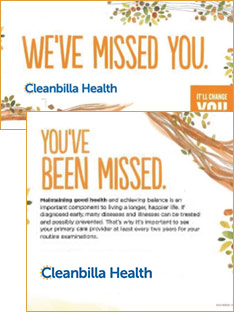
PROGRAM OVERVIEW
A large health care provider in the Midwest dedicated to supporting their 13 neighborhood primary care clinics looked to LionShare to help develop, execute and analyze an automated campaign designed to re-engage primary care patients who had let their provider relationship lapse. Knowing this sub-segment was a strategic focus for marketing, it was critical to incorporate control groups so downstream encounters could be measured post campaign that would accurately represent the true marketing impact.
Integrated Solution
Initial Discovery included identification of key audience segments and associated lapsed timeframes. Targets were identified as any primary care patient, age 18+ with a lapse in primary care services. Desired timeframe lapses were initially categorized at 12, 24 and 30+ months.
An oversized postcard was developed to motivate re-engagement as well as create awareness of the recently unveiled brand update. Building on the clean, streamlined creative standards that accompanied the updated brand, messaging was clear, concise and uncluttered. Key messaging focused on “We Miss You” with the call to action to schedule an appointment. To maximize limited budgets, a template was developed that allowed for variable versioning across all clinic locations at a cost-effective price point.
Based on early indicators, a few program adjustments were implemented to increase efficiencies. Given the streamlined nature of the program, these enhancements were easy to incorporate.
- Lapsed timeframes were limited to the 24 and 30+ months segments.
- Business rules were adjusted to increase age range to 25+.
- To avoid oversaturation within the patient households, all existing automated campaigns were prioritized and additional suppression levels were applied.
Results were scheduled to be reviewed at one year after campaign launch to allow for adequate sample sizes that would net statistically valid results. Due to overwhelming anecdotal campaign success, quantifiable analysis was rescheduled for one year later. At that point, downstream encounters, both primary care and system-wide, were measured against the control and previous anecdotal success was validated with quantifiable metrics.
With overwhelmingly successful results demonstrated at both the clinic and system level, the campaign continues on a monthly basis to nurture lapsed relationships. Potential enhancements include a second touch delivered digitally to nonresponders 3 months post initial touch.
Success Criteria |
Result |
| 1. Drive lapsed patients to re-engage at primary care level | Over a one-year report timeframe, the campaign delivered a 44% individual utilization rate |
| 2. Increase utilization rate | This campaign delivered an 8% increase in individual utilization rate over the control group |
| 3. Deliver positive incremental lift in payments at the primary care level | The campaign delivered a $276,492 incremental lift in payments. As an added bonus, over $1.2 million ($1,209,886.00) in incremental, systemwide payments were directly attributable to campaign. |
